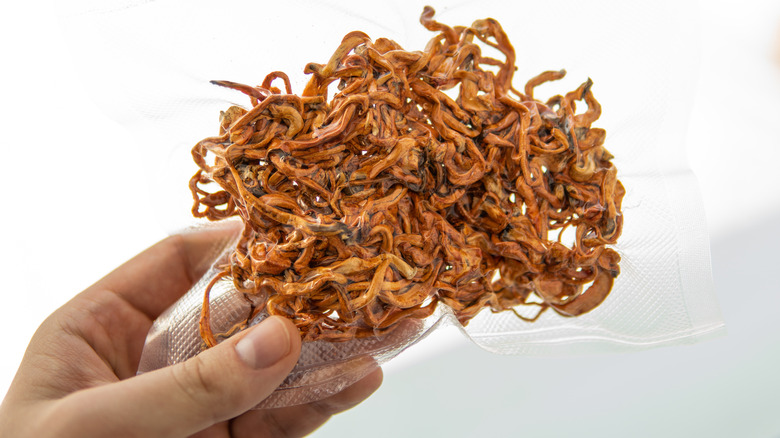The Real Reason Caterpillar Fungus Is More Valuable Than Gold
The classical "gold standard" system in which many countries fixed the value of their currencies in terms of a specified amount of gold hasn't existed for over 100 years, per the World Gold Council, but the expression still remains, as does interest in surprising items that, per gram, are more valuable than gold. Listverse reports that one such substance is a caterpillar fungus native to the Himalayas, known as yartsa gunbu, or "summer grass, winter worm." According to The Atlantic, it's actually a parasite created when a dead ghost moth caterpillar's body is overrun by the fungus Ophiocordyceps sinensis and it's long been used in Chinese medicine.
Demand for yartsa gunbu suddenly spiked in 1993 when a team of Chinese athletes broke several track and field world records and their coach attributed their athletic prowess to the consumption of caterpillar fungus. In 2003, its reputation grew even more when it was rumored that the fungus helped ward off SARS, a contagious respiratory illness caused by a coronavirus discovered in China in 2002. Prices rose by 20% each year from 1997 to 2012, and by 2018 the global market for the fungus was worth between $5 billion and $11 billion.
According to a 2011 story from NPR, yartsa gunbu is also known as "the Viagara of the Himalayas" and mentions of it can be traced back to the 15th century, when it appeared in a Tibetan medicinal text that noted it had "an ocean of aphrodisiacal qualities."
Several Himalayan economies rely on caterpillar fungus
The Atlantic notes that according to ecologist Kelly Hopping of Boise State University, people in Tibet don't refer to the caterpillar fungus in terms of Viagra, but rather to boost immunity or to treat a host of illnesses and diseases, including cancer. A 2011 paper published in the Journal of Ayurveda and Integrative Medicine (via PubMed Central) found that traditional healers in North Sikkum used yartsa gunbu to treat 21 ailments, including cancer, asthma, tuberculosis, diabetes, cough and cold, hepatitis, and, yes, erectile dysfunction. The article referenced several studies that supported the fungus' pharmacological potential, particularly its effects on liver and kidney function and the suppression of tumors, and recommended further study.
Demand for the fungus has had a massive effect on the countries where it originates. Per The Atlantic, it accounts for a significant portion of the gross domestic product of Bhutan, and according to geography professor Emily Yeh of the University of Colorado at Boulder, it's the most important source of cash income for people of many rural areas of Tibet. For the 2018 paper "The demise of caterpillar fungus in the Himalayan region due to climate change and overharvesting" (posted at the Proceedings of the National Academy of Science), co-author Kelly Hopping interviewed fungus collectors, several of whom noted that the harvests had thinned over the years. In addition to climate change affecting caterpillar fungus populations, overharvesting to keep up with demand was also part of the problem. Collectors, said Hopping, were "aware they're contributing to this, but they don't have an alternative."

